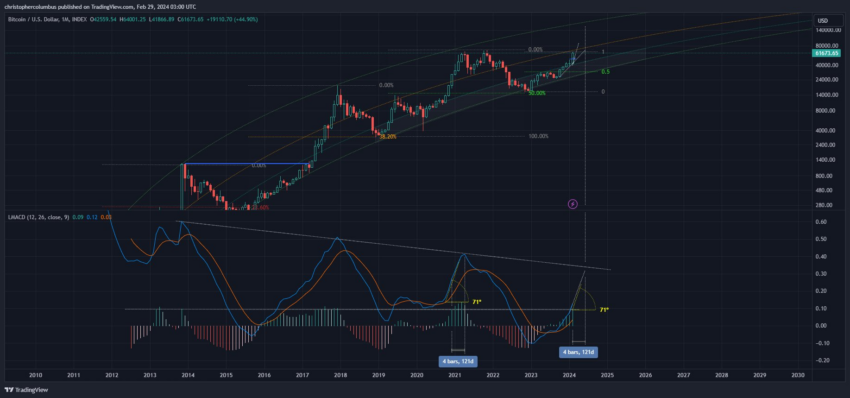ARTICLE AD BOX
The price of Bitcoin surged to above $60,000 yesterday following record net inflows into Bitcoin spot exchange-traded funds (ETFs). The increase has caused analysts to speculate whether BTC is riding a parabolic pattern that occurs every cycle.
Two analysts in the past week have highlighted how Bitcoin’s price in recent weeks mimics a parabolic surge seen in previous cycles.
Analysts See Repeat of Parabolic Bitcoin Surge
Crypto trader Dave the Wave said that the Moving Average Convergence Divergence (MACD) histogram suggests a previous four-month parabolic surge crypto trading pattern is set to recur. The MACD (blue line) shows changes in momentum by checking whether the difference between an asset’s 12-period and 26-month exponential moving averages crosses a signal line (orange).
If the difference is above the signal line, this signals a bullish trend. If the difference is below the signal line, this suggests a bearish pivot.
The MACD line has established itself above the signal line in the last few months. At the same time, the shape of the MACD histogram has become parabolic, suggesting a steep price increase soon.
Read more: Top 6 Cryptocurrency Trading Strategies for 2023
 MCAD Histogram Shows Parabolic Bitcoin Uptrend | Source: davethewave
MCAD Histogram Shows Parabolic Bitcoin Uptrend | Source: davethewaveRecently, on-chain analysis expert Kevin Svenson pointed out that Bitcoin reached the so-called “Base 3” price, i.e., the price at which Bitcoin touches a parabolic trend line, at $45,000. If the price continues to follow this trend, Svenson suggested that a double-up to $90,000 was possible.
Yesterday, the price of Bitcoin went up to $60,000. Around the same time, Mike Novogratz of Galaxy Digital said it’s hard to know where Bitcoin goes from here.
So far, inflows into Bitcoin spot ETFs appear to have largely driven the price increase. Yesterday, the net inflows into Bitcoin ETFs were $676.8 million, a new daily high. To date, the ETF providers have amassed $6 billion worth of Bitcoin.
Are Bitcoin ETFs a ‘Second Halving’?
Charles Edwards of Capriole Investments said that the demand for Bitcoin from ETF providers acts ‘like a second halving. He refers to the 2024 April Bitcoin halving that reduces the number of BTC released per mined block. Halvings, which occur roughly every four years, have historically been bullish events for the asset.
“The 2024 ETFs also act like a second halving with the amount of demand creation. As a result, 2024/5 is much more likely to represent a hybrid of the epic 2017 and average 2021,” Edwards noted.
The event, controlled by the Bitcoin mining software, halves the number of BTC miners can earn from broadcasting transaction blocks. From roughly April 19, miners will be awarded 3.125 BTC for every successfully mined block, compared to the 6.25 they earn now.
Read more: What Is Bitcoin Halving?
The event occurs roughly every four years and ensures that Bitcoin remains a deflationary currency. Michael Saylor, the executive chairman of the largest corporate holder of Bitcoin, Microstrategy, said earlier this year that the ETFs and mining would create twin demand and supply shocks.
So far, on-chain analysis suggests the first shock is underway. However, Bitcoin critic Peter Schiff says that a rally in gold could soon “prick the bubble.” BeInCrypto contacted Schiff for comment but had not heard back at press time.
The post Could Bitcoin Go Parabolic Before the Halving? appeared first on BeInCrypto.
.png)
 8 months ago
15
8 months ago
15








 English (US)
English (US)